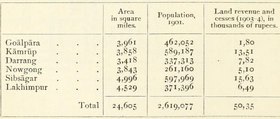Assam Valley
This article has been extracted from THE IMPERIAL GAZETTEER OF INDIA , 1908. OXFORD, AT THE CLARENDON PRESS. |
Note: National, provincial and district boundaries have changed considerably since 1908. Typically, old states, ‘divisions’ and districts have been broken into smaller units, units, and many tahsils upgraded to districts.Many units have since been renamed. Therefore, this article is being posted mainly for its historical value.
Assam Valley
A Division in Eastern Bengal and Assam, consist- ing of the valley of the Brahmaputra between 25 28' and 27 52' N. and 89° 42' and 96 5' E., shut in between the Himalayas on the north and the Assam Range on the south. The head-quarters of the Commissioner are at Gauhati Town. The population of the Division at the last four enumerations was: (1872) 1,884,046, (1881) 2,252,003, (1891) 2,476,481, and (1901) 2,619,077. The slow rate of increase during the last decade is due to the exceptional unhealthiness that pre- vailed in the central portion of the valley. The total area is 24,605 square miles, and the density of population 106 persons per square mile, which is rather above that of Assam as a whole. In 1901 Hindus numbered 72 per cent, of the population, animistic tribes 18 per cent., and Musalmans 10 per cent. Other religions included Jains (1,600), Buddhists (7,940), and Christians (12,526), of whom 11,151 were natives. The Division contains six Districts, as shown below : —
The greater part of the Division consists of a level plain, lying on both sides of the Brahmaputra. In the centre is a tract of hilly country known as the MIkIr Hills, which is cut off from the main mass of the Assam Range by the valleys of the Dhansiri and the Langpher. The Division contains 10 towns, rather more than half the total number in Assam, and 8,801 villages.
The largest towns are Gauhati (11,661) and Dibrugarh (11,227). The chief centres of trade are Goalpara, Barpeta, Gauhati, Tezpur, and Dibrugarh. The Assamese have, however, no commercial aptitude ; and the fact that tea is the principal industry of the Division prevents the formation of business centres, each large garden serving as a nucleus for local trade. Kamakhya and Hajo in Kamriip, and the pool of Brahmakund at the eastern end of the valley, are places of pilgrimage to which devout Hindus come from all parts of India. Gauhati is locally identified with a town mentioned in the Mahabharata, and Tezpur possesses interesting arehaeological remains. Sibsagar and Nazira were the capitals of the Ahom kingdom.
